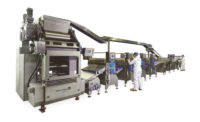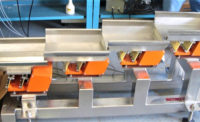Automation, ease of operation, cleanability, sustainability, and flexibility are among the characteristics that snack food and wholesale bakery customers say they want to see in laminating and sheeting equipment, according to manufacturers. Many of these concerns are driven by the “great resignation” and resulting difficulties attracting and retaining workers.
Views from the field
Nick Magistrelli, vice president of sales with Rademaker USA, Hudson, OH, says his customers keep asking about sanitation and user-friendliness. “We’ve put some emphasis on making our equipment easier to operate,” he says. “It’s not an overnight change. But it’s making them as basic as possible, especially with the challenging workforce situation our customers are having, and all the turnover.”
In some cases, automation seems like the best solution. One Rademaker customer said he had 170 people lined up to work on a Saturday, and 93 showed up. “He’s got to look at this business model differently and try to automate,” Magistrelli says. “Where there used to be areas of manual intervention, now bakers are trying to eliminate that by streamlining that automation process. … Customers used to have no problem having 20 to 30 people bending and pinching croissants. Now, there’s automated bending and pinching solutions to streamline that process.”
Flexibility has been another watchword for Rademaker’s customers, many of whom are looking for unique fit tooling, Magistrelli says. “That allows the operator to make a changeover in a faster period of time, and do it in a more reliable manner,” he says. “A unique fit tooling setup doesn’t allow them any option other than to put the tooling in the right location on the line. There’s no guesswork anymore. You don’t have to blow through a mile of dough before you get it right.”
AMF Bakery Systems, Richmond, VA, hears from customers regularly about the need for both sustainability and digitalization, says Hans Besems, executive product manager for sheeting and laminating. “Those are the key drivers for most of our customers,” he says. “Almost every big bakery has sustainability in its goals. We try to innovate as much as possible.” Current needs include tools for predictive maintenance and reducing reliance on operators input.
These goals come together with innovations like a smart oven app that constantly monitors energy use and heat loss, which Besems says saves 30 percent to 40 percent of gas use in a given year, and an oven that runs on 100 percent hydrogen—leading to zero carbon dioxide emissions. “Other trends are less waste, less water use, and hygienic design,” he says. “We’re talking to people about bio-digestibles—taking scrap dough and turning it back into water, or another product that can be reused.”
Modular and flexible systems also have proved popular of late with customers, who find them “very helpful to scale up with add-ons, with upgrades, with special kits,” Besems says. “That doesn’t mean replacing a full line, but increasing capacities on a small line. Once they get bigger, they can easily upgrade.”
David Moline, vice president, sales and marketing, Moline Machinery, Duluth, MA, says his customers regularly talks about features like improved washdown systems and sheet monitoring systems. “That is certainly something we can provide value-added options to the baker based on their needs,” he says. “We’re always making continuous improvements to the mechanical designs and controls.”
Particularly for wider systems, sideload automatic flour dusters have become almost standard, Moline says. “Manually, it’s an ergonomic benefit, but it’s also an assurance that flour duster hoppers are getting filled evenly,” he says. “That also can be an entry point into, if you have a bulk pneumatic flour duster, it can become fully automated. You could then upgrade to a flour silo pneumatic delivery system, and you would not have to worry about operators filling dusters at all.”
Lastly, flexibility is an important quality for any sheeting system, Moline says. “That’s for adding a little space for future tooling, or a modular cutting station,” he says. “Sometimes, you may need rotary cutting; sometimes, you may need guillotine.” You don’t necessarily have to add it at the beginning, but if you account for it upfront, that makes it easier. “And it’s definitely becoming a requirement of a sheeting line to handle synchronized cutting and depositing.”
New developments
Baker-Perkins is focusing on making its range of laminators and sheeters for crackers, baked snacks, and hard sweet biscuits uncomplicated and undemanding to operate, control and maintain, given the de-skilled nature of the current workforce, Graham says. “That involves applying the principles of our TruClean standard, which meets the highest maintenance and hygiene demands, and ensuring all machinery is Industry 4.0/Industrial Internet of Things (IIoT) ready,” he says.
The company’s improvements to its three-roll sheeter typify that progress to date, Graham says. The unit consistently provides sheets in production down to the three-millimeter threshold that’s the thinnest the industry demands, he says, and the three-roll sheeter has proved highly effective in separating scrap return dough from fresh dough, while operating with fewer components and greater access than four-roll alternatives.
“Recent upgrades include removable sheeter side cheeks for access to clean the ends of the rolls and the hopper, which were previously inaccessible,” Graham says. “This is an important development for hygiene-conscious manufacturers, particularly those working to allergen standards. The cartridge conveyor linking sheeter and gauge roll is self-tracked and performs reliably without the need for a tracker. This reduces maintenance and also allows the complete unit to be easily lifted out or tilted for access.”
The ability to remove all external covers, along with the replacement of greasy chains and gears with direct drive motors, provide both a hygiene advantage and a process improvement, Graham adds. “There is now individual control of key operating parameters, including roller speed, which previously relied on chain linkage,” he says.
AMF Bakery Systems has introduced the Tromp Fat Pump, which ladles butter or margarine on top of dough for laminating purposes, Besems says. Changes in design have led to a shorter path to the dough sheet, avoiding the pressure and moisture loss of the butter or other fat; and the temperature stays lower than in past machines, which means “you don’t lose important properties of the butter, with better results in the end.”
The new laminator’s design is easier to clean, with less tooling needed, as well as more efficient and more sustainable than past generations from AMF, Besems says. “We’re designing our machines with methods of working toward sustainable and easy-to-use equipment as much as possible,” he says. “We’ve redesigned it for more open frame, which means better hygiene. Belt cleaning and belt drying is much easier. The flour dusters can be cleaned more easily and more often. We also improved the flour system for more efficient ‘flouring’ because sustainability is one of our strategic goals. This new system can use 20 percent to 30 percent less flour to get the same results, in keeping the dough from sticking to the belts.”
Moline says his company produces a broad range of custom laminators and sheeters. “Depending on the requirements of the line, we’ve been doing a lot of extreme-washdown environment laminating and sheeting systems, specifically for USDA bakeries,” he says. “Meat and egg fillings are becoming more commonplace for sheeting applications. Pocket-style products, like calzones, or breakfast-type products, is an area we’ve been doing a lot in sheeting.”
The company also has made advancements in automated dough-sheet tension monitoring systems, Moline says. “The demands of bakers are for wider and faster systems, where if you have problems on a sheeting line, it’s difficult for a single operator to manage that, especially on laminating system, where dough-sheet monitoring comes in handy. Our systems make subtle adjustments on the fly to prevent bunching, tearing or anything else related to dough inconsistency.”
Going into 2022, Rademaker plans to put more emphasis on its mid-range Radini sheeting platform, where the company has a customer base and a solid reputation built on custom solutions, Magistrelli says.
“Give us a product, available space and capacities, and we put together a concept and tell you what it costs,” he says. “There’s options, but there’s standard options that, you can’t really go outside the box. ‘I want to make a doughnut. I want to make a Danish.’ We say, ‘If you’re at a certain capacity, and it fits inside the Radini box, we’ve got a solution for you.’”
As such, the Radini amount to a “catalog-type order,” Magistrelli says. “Here are the components you can by, this is the capacity, this is how it’s going to be equipped. It’s built for the mid-range customer, not a traditional wholesale corporate account. … It can be a straight sheeting line, or it can be a laminator, or a puff pastry line. We feel there’s a place in the marketplace for it. Customers seem receptive.”





